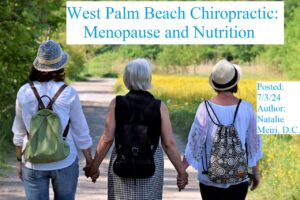
Chiropractic in West Palm Beach: Menopause and Nutrition is about how to minimize or eliminate the unpleasant side effects of menopause.
Menopause is the point at which a woman stops ovulating and menstruation ceases, indicating the end of fertility. It is a natural progression in life. Many women experience few if any symptoms during this time. However, others may suffer from some, or all, of the following: anxiety, dry skin, fatigue, feelings of bloating, headaches, heart palpitations, hot flashes, insomnia, irritability, decreased interest in sex, loss of concentration, mood swings, night sweats, reduced stamina, urinary incontinence, vaginal dryness and itching, weight gain, cold hands and feet, joint pain, hair loss, and skin changes.
Above all, though a natural progression in life, it is the time women become increasingly vulnerable to other, potentially serious health problems. Over the long term, the diminished supply of estrogen increases the likelihood of cardiovascular disease, osteoporosis, and vaginal atrophy. Remarkably, all the above can be avoided through a proper diet, nutritional supplements, exercise and chiropractic care.
Menopause Symptoms
After 12 months without menstruating, a woman is in menopause. The average age of menopause onset in the Unites States is 51. Decreased circulating levels of estrogen with menopause appear to affect the central nervous system via the hypothalamus. The hypothalamus is a small but important area in the center of the brain between the pituitary gland and thalamus. It plays an important role in hormone production and helps to stimulate many important processes in the body. The hypothalamus controls body temperature, thirst, hunger, and other homeostatic systems. It is also involved in sleep and emotional activity.
So 95% of perimenopausal and menopausal women experience “hot flashes”. These flushing and sweating episodes are sudden in onset and last several minutes. A sensation of face and neck hotness extends to the front of the chest. The skin temperature may increase as much as 5° and may result in wetting of clothing through excess perspiration. Physiologic responses that also occur include an increase in heart rate perceived sometimes as palpitations.
Furthermore, there may be symptoms of headache, dizziness, and nausea during the episodes. Many women have night sweats and also have difficulty falling asleep. And often awaken early without being able to fall back to sleep. Approximately 80% of women experience these episodes for more than 1 year with as many as 20% of women having symptoms for more than 5 years.
The Hormones involved in Menopause
Many years before a woman stops ovulating, her ovaries slow their production of the hormones estrogen, progesterone, and testosterone. Estrogen and progesterone are commonly thought of as sex or reproductive hormones. While estrogen is indeed essential for reproduction, it also acts on many nonreproductive organs and systems in the body. Cells in the vagina, bladder, breasts, skin, bones, arteries, heart, liver, and brain all contain estrogen receptors, and require this hormone to stimulate these receptors for normal cell function.

Helpful Supplementation/Lifestyle Recommendations for Menopause
Beta-1, 3-D-glucan– (a fiber can be found in oats, barley, and some mushrooms. Boosts immune system and gives anti-aging nutrients.
Cerasomal-cis-9-cetylmyristoleate- found in certain animals, including cows. Helps joint to keep lubricated and inflammation down.
Coenzyme Q10 plus Coenzyme A- Helps with overall physical- mental processes in body.
Dehydroepiandros-terone (DHEA)- Boosts your memory function and helps with stress.
Essential Fatty Acids (primrose oil, black currant seed oil)- Has sedative and diuretic characteristics. Helps in estrogen production.
Lecithin capsules– group of fatty substances found in plant and animal tissues. Acts as a base for vitamin E to help reduce hot flashes and menopause symptoms
Multienzyme complex with Hydrochloric acid (HCL)- Aids digestion. And HCL declines with age
Soy or flax protein– Has phytoestrogen plant compounds with structures similar to estrogen. Eat fermented soy products or flax if you can’t tolerate soy.
Vitamin B complex and extra pantothenic acid (Vit B5) and Pyridoxine/folic acid (Vit B6)- increases circulation, minimizes water retention, and anti-stress to help adrenals.
Cholecalciferol (Vitamin D3)- manages calcium in the body
Vitamin E– helps with hot flashes
Boron– helps with calcium absorption
Calcium and Magnesium– protects bone density and is calming
Quercetin – a plant pigment is an antioxidant flavonoid, found in fruits and vegetables. May help with hot flashes
Silica– needed for connective tissue and calcium absorption
Zinc and copper- helps to reduce menopause symptoms and bone loss
L-Arginine and L-lysine– enhances liver function
Multiglandular complex– may stabilize hormone balance
Multivitamin and mineral complex with potassium and selenium- helps complete nutrition which is needed for decreasing symptoms. Potassium aids nervous system function and can be depleted during perspiration in hot flashes. Selenium may be needed for hormonal balance.
Vitamin C plus mixed bioflavonoids– important to decrease symptoms and for heart health.
Herbs- Anise, black cohosh, fennel, licorice, raspberry, sage, unicorn root, and wild yam root are natural estrogen promoters. Hops and valerian root help to calm the body and promote better sleep. Ginseng has been shown to help improve mood during menopause. Kava kava decreases anxiety. Gotu kola, black cohosh, red clover, and dong quai decrease hot flashes, vaginal dryness, and depression. St. John’s wort is helpful if you suffer from anxiety or depression. Siberian ginseng aids in symptoms of depression and in estrogen production.
Menopause Diet/Lifestyle Recommendations
Firstly, a healthy, unprocessed diet is crucial for helping your body get used to the hormonal changes. Eat tons of fruits and veggies, high fiber foods, clean and lean proteins like fish mostly and minimum amounts of meat, healthy fats such as olive and coconut oil, and foods that supply natural phytoestrogens. These include: soybeans, flaxseeds, nuts, whole grains, apples, fennel, celery, parsley, and alfalfa.
Secondly, a high intake of phytoestrogens is thought to explain why hot flashes and other menopausal symptoms rarely occur among women in Asian cultures. Nevertheless, if you have breast, uterine, or ovarian cancer, or have had or are at risk for any of these, avoid soy.
Thirdly, avoid dairy products as much as possible. For example, limit your consumption to small amounts of low-fat yogurt if you must have dairy. Dairy products and meat promote hot flashes. Make sure you take calcium and vitamin D as supplements to reduce your risk of osteoporosis.
Fourthly, amaranth, chickweed, dandelion greens, nettle, seaweed, and watercress are rich in calcium and can help prevent osteoporosis. Interestingly, seaweed and soy foods are commonly consumed in Japan, where 10 to 20 percent of women experience hot flashes compared to 70 to 80 percent in Western countries.
Fifthly, avoid alcohol, caffeine, sugar, spicy foods, and hot soups and drinks. They can trigger hot flashes, aggravate urinary incontinence, and make mood swings worse. They also make the blood more acidic, which prompts the bone to release calcium to act as a buffering agent. This is an important factor in bone loss.
Sixthly, get regular moderate exercise. Exercise is important for cardiovascular health and for building bone density. Also, exercise helps decrease stress levels and increase natural endorphins (brain’s feel-good neurotransmitters/chemicals).
Lastly, substitute garlic or onion powder for salt when cooking. Excessive salt increases urinary excretion of calcium. Try to drink 2 quarts of quality water or/and herbal tea each day. This will help prevent drying of the skin.

Menopause and Joint Pain
A common symptom often associated with hormonal changes is pain. More than half of women experience arthralgia (pain in a joint) around the time of menopause. The causes of joint pain in postmenopausal women can be difficult to determine as the period of menopause coincides with a rising incidence of chronic rheumatic conditions such as osteoarthritis. Nevertheless, the prevalence of arthralgia does appear to increase in women going through menopausal transition. Studies have shown this to result from reduction in estrogen levels. This may have to do with various interactions between sex hormones and pain processing pathways, immune cells and chondrocytes (cartilage cells).
Given a growing concern regarding estrogen replacement therapy, a search for alternatives in the management of menopause is prevalent. Many studies have found that the use of alternative therapies for menopause symptoms is common, and women who use them generally find them to be beneficial. Chiropractic intervention in the treatment of postmenopausal climacteric symptoms especially in the area of joint pain and many other symptoms is effective.
If you are suffering from menopause or just need more wellness, contact your chiropractor in West Palm Beach. Call 561-253-8984 to make an appointment or to learn more about West Palm Beach Chiropractic: Menopause and Nutrition.
References:
Prescription for Nutritional Healing (3rd edition), Phyllis A. Balch, CNC
Thomas Souza, (2018) Differential Diagnosis and Management for the Chiropractor
*For all the above, please check with your primary care doctor before implementation of supplement recommendations.